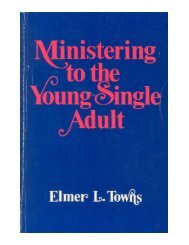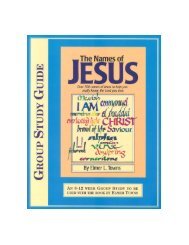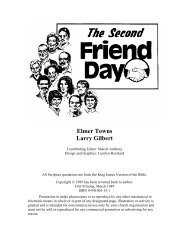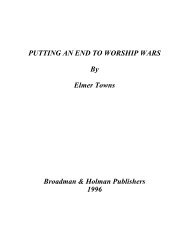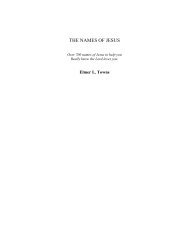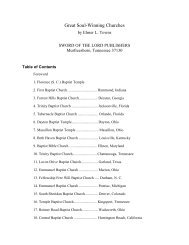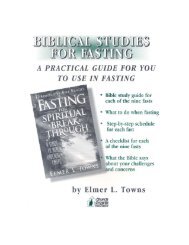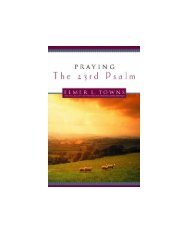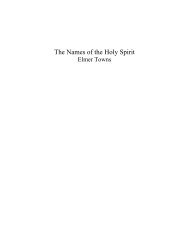A Journey Through The Old Testament - Elmer Towns
A Journey Through The Old Testament - Elmer Towns
A Journey Through The Old Testament - Elmer Towns
You also want an ePaper? Increase the reach of your titles
YUMPU automatically turns print PDFs into web optimized ePapers that Google loves.
of action in that city, it was he who lost his life. “Thus God repaid the wickedness of Abimelech,<br />
which he had done to his father by killing his seventy sons. And all the evil of the men of<br />
Shechem God returned on their own heads, and on them came the curse of Jotham the son of<br />
Jerubbaal” (Jud. 9:56-57).<br />
THIRTY<br />
RUTH:<br />
<strong>The</strong> Romance of Redemption<br />
(Ruth 1:1-4:22)<br />
About the time Gideon was hiding in the winepress to escape the dangers of a Midianite<br />
invasion, a small village to the south was caught up in the midst of a severe famine. This famine<br />
may have been the natural consequence of the successive invasions of the Midianites during the<br />
harvest seasons, or simply the result of a prolonged drought. Some Bible commentators suggest<br />
the combination of these two factors resulted in its severity. Like the other dozen famines<br />
recorded in Scripture, this famine also appears to have been a physical manifestation of the<br />
judgment of God.<br />
<strong>The</strong> account of this famine is recorded in the opening verse of the Book of Ruth,<br />
originally appended to the Book of Judges. Yet unlike the Book of Judges, Ruth is an account of<br />
what was going right in Israel. It records people praying and seeing answers to their prayers<br />
without the cycle of oppression so common in the Book of Judges. Yet it is obvious from several<br />
contextual hints in the two books that these event occurred simultaneously.<br />
Ruth begins with the expression, “Now it came to pass, in the days of.” A form of this<br />
expression occurs five times in the <strong>Old</strong> <strong>Testament</strong> and always denotes impending trouble,<br />
followed by internal disorders and outward oppressions. <strong>The</strong> crisis age referred to in this context<br />
is simply described as “when the judges ruled” (Jud. 1:1). This was an era of apostasy and<br />
anarchy (cf. 2:10-13; 21:25). Though some Jewish commentators tend to identify the Boaz of<br />
this book with the otherwise unknown judge Ibzan of Bethlehem (12:8-10), the genealogy of the<br />
last chapter linking Ruth and Boaz to David suggests an earlier context; i.e., during the rule of<br />
Gideon. This would also account for the dramatic change in conditions during the decade in<br />
which the first chapter of the book is set.<br />
But the Book of Ruth is more than a history of a family in Bethlehem. It is a love story of<br />
how a poor but virtuous widow finds her rest and fulfillment through a marriage to one of the<br />
wealthiest and most honorable men of the city. But it is also more than a love story. It is an<br />
account of faith in which a number of prayers are offered to God and without exception<br />
answered to the benefit of the one praying. But it also more than an account of faith. It is the<br />
story of how a Moabite girl, who was an alien from the commonwealth of Israel and by law<br />
under the curse of Moab, found redemption in the village of Bethlehem and was accepted into<br />
the society of the people of God. And in all this, it is a picture of every believer’s relationship to<br />
God. It is the romance of redemption, a picture of what faith can and does accomplish in the life<br />
of every believer.



